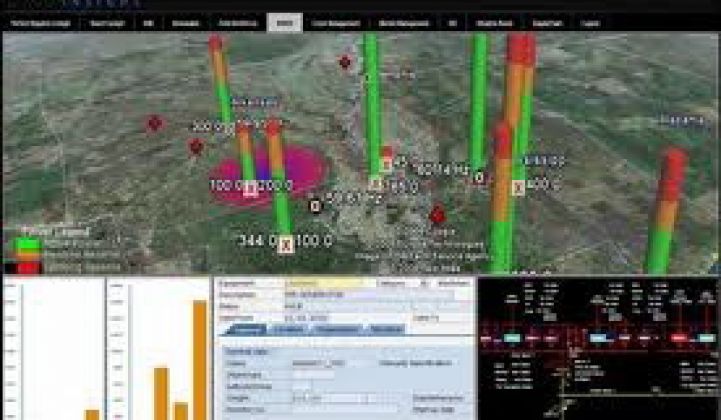Space-Time Insight has built a business on crunching loads of real-time data and mapping it to geospatial models to help utilities make sense of it all. Since its 2007 founding, it has lined up customers including Florida Power & Light, San Diego Gas & Electric, California ISO and, in an under-the-radar fashion, Cisco Systems.
On Tuesday, the Fremont, Calif.-based startup launched a “situational intelligence suite” of products, starting with a smart meter intelligence business application, meant to plug directly into utility deployments en masse. It’s the first in what’s intended to be a string of out-of-the-box systems to take utility asset management, smart grid and renewable power integration data and map it out on screen, in near-real time.
That’s how Steve Ehrlich, vice president of marketing, described Space-Time Insight’s plan for taking its visualization, analytics and “situational intelligence” technology to a wider audience. While it hasn’t named any customers for the new application, it already has some testing out the applications it’s now rolling out as products.
“Most of the systems being deployed capture and store all the basic meter events, the errors around data, etc.,” Ehrlich told me in an interview last week. “What those systems generally do not do, or do in a simple way, is integrate the data from multiple systems. Their ability to display analytics based on customer information, weather, real-time grid information, is really non-existent.”
This sounds like a familiar argument. Over the past few weeks, we’ve seen a host of products and services aimed at linking multiple, disparate smart meter networks, including SK Telecom’s GridMaven U.S. subsidiary, Cisco’s field area network and network management system products, startup Proximetry’s cloud-based network management platform and the launch of a meter data analytics suite from meter data management provider (and Siemens acquisition) eMeter.
Space-Time isn’t seeking to replace these types of platforms, but rather to augment them, Ehrlich said, particularly in the geospatial and visual analytics department. “Their analytics are fine, but they don’t have any geospatial capabilities,” he said of today’s smart meter management systems. “Their options are build it, license it, or partner. That’s kind of where we fit in.”
The startup has some pretty cool visuals to show off in support of its claims, including its geospatial platform for California ISO, which helps the state grid operator manage data from grid sensors, wind farms, weather feeds and other disparate sources.
Space-Time is also a listed partner of Cisco’s smart grid ecosystem. While Ehrlich wouldn’t say much about how the two work together, he did confirm that a software demo that Cisco CEO John Chambers conducted for an audience in September was using some of the startup’s technology -- a fact that emerged in comparing the likeness between the geospatial software Chambers showed on stage and the system Ehrlich demonstrated in an online presentation.
Ehrlich wouldn’t get into more details on how Space-Time may be working with Cisco, beyond providing a visual interface for the networking giant’s grid operations and workforce and asset management systems.
To manage the massive amounts of data involved, Space-Time Insight has integrated its technology with SAP HANA and can offload processing to data systems like EMC Greenplum -- the same platform that Silver Spring Networks recently announced it was working with to manage smart grid data. Space-Time is also working with IBM, OSIsoft, Accenture and Oracle on the massive data integration needs that today’s smart meter deployments have brought to utilities.
Space-Time has some roots in the big data world: its CEO, Robert Schilling, is a former senior vice president and GM of SAP North America, and the company was formed by Oracle vets, said Ehrlich. One of the reasons the startup chose smart metering as its first application is because utility customers are struggling with that area of operations, he noted.
“The primary focus of our customers has been revenue protection, and on making sure that customers are satisfied and happy with the meters,” Ehrlich noted. While today’s smart meters are beginning to turn on additional features like outage detection, remote connect-disconnect and voltage-sensing capabilities, they’ve also seen some problems in delivering accurate bills to customers.
Looking at the next set of applications on offer, utilities “see operational benefits by getting more people to work together,” he said. “What our software does for them is allow them to get up and running in a matter of weeks.” Renewable power integration could be one particularly interesting field, given how hard it’s going to be for utilities in solar and wind power-rich states like California and Texas to manage all of that on-again, off-again intermittent power.
Space-Time Insight saw about 300 percent revenue growth last year, Ehrlich said. It raised a Series A round in 2009 from Opus Capital, and while the parties didn’t disclose the dollar amount, one source pegged it at $2 million.
This won’t be the last company announcing newer and better ways of integrating smart grid data this week. The DistribuTECH conference in San Antonio, Texas is bound to see more such news. Stay tuned for more details.



